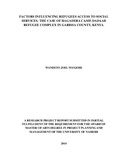| dc.description.abstract | The study was to establish the factors that influence refugees‟ access to social services in
Hagadera refugee camp within Dadaab refugee camp, Garissa County, Kenya. It was guided
by the following specific objectives: to establish the extent to which donor funding influence
refugees‟ access to social services in Hagadera refugee camp, to determine if social factors
influence refugees‟ access to social services in Hagadera refugee camp and to find out if
institutional factors influence refugees‟ access to social services in Hagadera refugee camp.
The study adapted a descriptive survey research design. A descriptive survey examines a
situation as it is and yields quantative information that can be summarized through statistical
analyses. The sample of respondents was determined using random sampling which relies on
mere chance to determine who would be selected in the sample. The target population was
1800 households. In total two types of stakeholders were involved in the study: the refugees
and workers in humanitarian organizations. Methods of data collection used were both
primary and secondary. Primary data was collected from questionnaires that were distributed
to the refugees, NGO employees, and even security agents. Secondary data was obtained
from UNHCR and NGO records. The qualitative data obtained was summarized and
organized according to common themes and presented using statistical package for social
science (SPSS) to generate frequency distributions and percentages to assist the researcher in
answering the research questions.
The main findings of the study indicated that donor funding was a major contributor to
refugees accessing social services in Hagadera camp with all the humanitarian agencies
depending wholly on donor funding. The respondents were of the view that the provision of
social services to the refugees was directly proportional to the amount of donor funding
released. It was also noted that humanitarian organizations were not receiving enough funds
to drive their humanitarian agenda. They also indicated that corruption, wastage of resources,
insufficient, poor quality services, misappropriation of resources, poor administration, poorly
trained teachers and school management and unequal service distribution were some of the
problems they faced in accessing education as a social service within Hagadera refugee
camp.
The study concluded that refugees were not receiving adequate social services and therefore
recommended a number of things. The refugees should be made more aware of the services
that are provided within the camp by various agencies through the most effective means
possible. Donor funding should be increased and made more flexible. Humanitarian
organizations should diversify their sources of funds to ensure that they have a solid financial
base as well as having a clear organization structure with well-defined criteria for selection of
service providers, their qualifications, in-service training timetables. They should also
minimize wastage of resources assigned to them by donors by coming up with strict
guidelines on financial matters. The refugees should also be empowered and helped to feel
that they have a role to play in shaping their destiny. Finally security surveillance should be
enhanced more within the camp to ensure that refugees feel safe while going to access social
services within the camp. | en_US |

